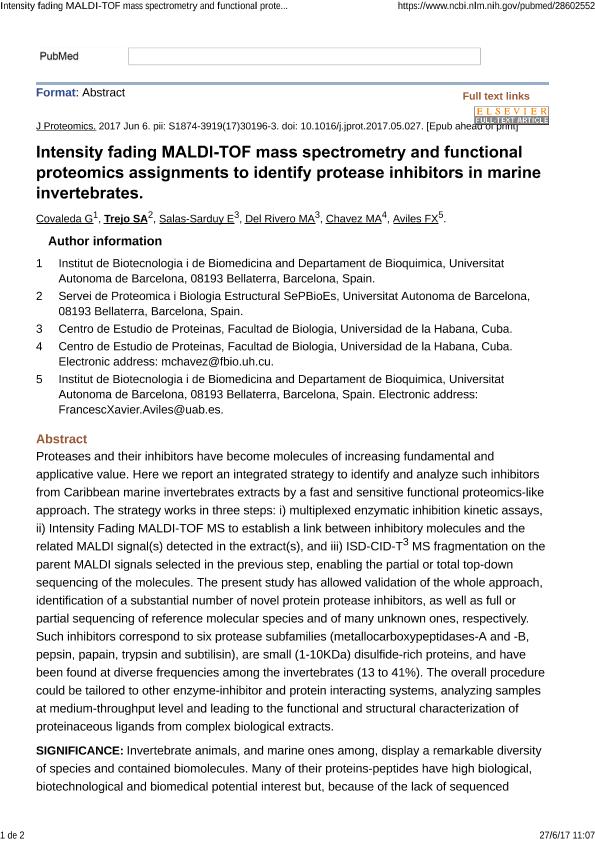Artículo
Intensity fading MALDI-TOF mass spectrometry and functional proteomics assignments to identify protease inhibitors in marine invertebrates
Covaleda, Giovanni; Trejo, Sebastian Alejandro ; Salas Sarduy, Emir
; Salas Sarduy, Emir ; del Rivero, Maday Alonso; Chavez, Maria Angeles; Aviles, Francesc X.
; del Rivero, Maday Alonso; Chavez, Maria Angeles; Aviles, Francesc X.
 ; Salas Sarduy, Emir
; Salas Sarduy, Emir ; del Rivero, Maday Alonso; Chavez, Maria Angeles; Aviles, Francesc X.
; del Rivero, Maday Alonso; Chavez, Maria Angeles; Aviles, Francesc X.
Fecha de publicación:
08/2017
Editorial:
Elsevier Science
Revista:
Journal Of Proteomics
ISSN:
1874-3919
Idioma:
Inglés
Tipo de recurso:
Artículo publicado
Clasificación temática:
Resumen
Proteases and their inhibitors have become molecules of increasing fundamental and applicative value. Here we report an integrated strategy to identify and analyze such inhibitors from Caribbean marine invertebrates extracts by a fast and sensitive functional proteomics-like approach. The strategy works in three steps: i) multiplexed enzymatic inhibition kinetic assays, ii) Intensity Fading MALDI-TOF MS to establish a link between inhibitory molecules and the related MALDI signal(s) detected in the extract(s), and iii) ISD-CID-T3 MS fragmentation on the parent MALDI signals selected in the previous step, enabling the partial or total top-down sequencing of the molecules. The present study has allowed validation of the whole approach, identification of a substantial number of novel protein protease inhibitors, as well as full or partial sequencing of reference molecular species and of many unknown ones, respectively. Such inhibitors correspond to six protease subfamilies (metallocarboxypeptidases-A and -B, pepsin, papain, trypsin and subtilisin), are small (1–10 KDa) disulfide-rich proteins, and have been found at diverse frequencies among the invertebrates (13 to 41%). The overall procedure could be tailored to other enzyme-inhibitor and protein interacting systems, analyzing samples at medium-throughput level and leading to the functional and structural characterization of proteinaceous ligands from complex biological extracts. Significance Invertebrate animals, and marine ones among, display a remarkable diversity of species and contained biomolecules. Many of their proteins-peptides have high biological, biotechnological and biomedical potential interest but, because of the lack of sequenced genomes behind, their structural and functional characterization constitutes a great challenge. Here, looking at the small, disulfide-rich, proteinaceous inhibitors of proteases found in them, it is shown that such problem can be significatively facilitated by integrative multiplexed enzymatic assays, affinity-based Intensity-Fading (IF-) MALDI-TOF mass spectrometry (MS), and on-line MS fragmentation, in a fast and easy approach.
Archivos asociados
Licencia
Identificadores
Colecciones
Articulos(IMBICE)
Articulos de INST.MULTIDISCIPL.DE BIOLOGIA CELULAR (I)
Articulos de INST.MULTIDISCIPL.DE BIOLOGIA CELULAR (I)
Citación
Covaleda, Giovanni; Trejo, Sebastian Alejandro; Salas Sarduy, Emir; del Rivero, Maday Alonso; Chavez, Maria Angeles; et al.; Intensity fading MALDI-TOF mass spectrometry and functional proteomics assignments to identify protease inhibitors in marine invertebrates; Elsevier Science; Journal Of Proteomics; 165; 8-2017; 75-92
Compartir
Altmétricas



